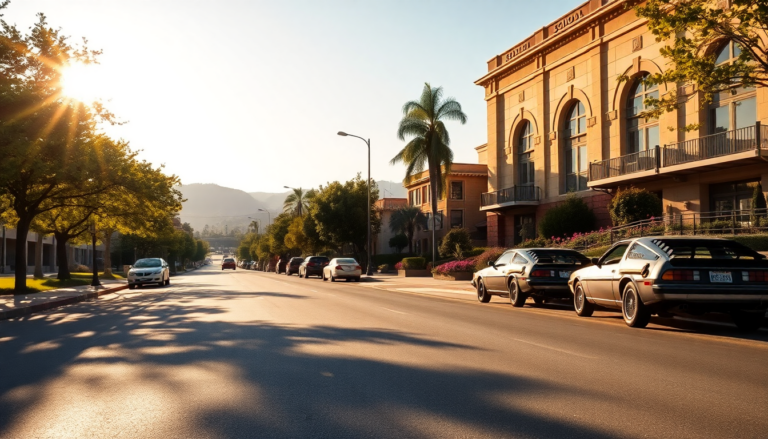Argomenti trattati
Prepare to embark on a sensory journey through time as we revisit the iconic locations that brought the beloved saga of Back to the Future to life. The enchantment of this trilogy, which began captivating audiences in 1985, lies not only in its clever storytelling and unforgettable characters but also in the tangible places that serve as the backdrop for Marty McFly’s adventures. As we traverse these remarkable settings, we’ll uncover the essence of each location, reminding us that behind every scene, there’s a story waiting to be told.
Whittier High School: The Stage of First Encounters
When you think of Back to the Future, it’s impossible not to picture Whittier High School, where young George and Marty McFly navigated the trials of adolescence. This real-life school, located in Whittier, California, still retains its classic façade, complete with the iconic entrance and staircase featured in various scenes of the film. Standing before these doors feels like stepping into a time capsule, ready to witness Marty’s electrifying performance of “Johnny B. Goode” at the high school prom—a moment that transcends generations.
In this scene, the palpable energy radiates from Michael J. Fox‘s portrayal of Marty, as he introduces a song that has yet to be written in 1955. His line, “I guess you guys aren’t ready for that yet. But your kids are gonna love it,” perfectly captures the film’s playful commentary on cultural shifts. It’s through such moments that the trilogy connects the past with the future, inviting audiences to reflect on the evolution of music and society.
The Enigmatic Courthouse Square
Arguably the most iconic location of the trilogy is Courthouse Square, nestled within Universal Studios in Hollywood. This set has become synonymous with the film’s climactic moments, particularly the scene where lightning strikes the clock tower. As Doc Brown connects the cable and Marty accelerates the DeLorean to 88 miles per hour, the tension is palpable, and the stakes could not be higher. This monumental moment in cinematic history is not merely about the characters but also about the place that holds the memory of that dramatic night.
Although the square has undergone modifications over the years for various productions, much of its original charm remains. Visiting this location feels like stepping into the heart of Hill Valley, where time and reality intertwine. The historical significance of Courthouse Square extends beyond the film; it serves as a reminder of the powerful narratives that can unfold in familiar settings, inviting us to explore our own connections to the places we inhabit.
Jamestown: A Western Dreamscape
Next, we travel to the picturesque town of Jamestown, California, the backdrop of Back to the Future Part III. This charming locale, known for its well-preserved railway, captures the essence of the Old West, making it the perfect setting for the film’s exploration of time travel. The town’s designation as a California Historical Landmark speaks to its cultural significance and enduring appeal.
In Back to the Future Part III, the plot revolves around the powerful locomotives that shaped the town’s identity. The lush aesthetics of Jamestown create a captivating environment that has not only featured in the trilogy but also in other notable films, showcasing its versatility and charm. Here, visitors can immerse themselves in the history of the railway while encountering props from the film, including the iconic train from Back to the Future Part III, housed in a local museum.
Monument Valley: The Wild West Reimagined
As Marty McFly journeys back to 1885, he finds himself in the breathtaking landscapes of Monument Valley, straddling the border of Arizona and Utah. This location, celebrated for its stunning red rock formations, has served as a backdrop for countless Westerns, and its natural beauty adds a layer of authenticity to the film’s setting. The vast expanses of Monument Valley echo the spirit of adventure and exploration that characterizes the trilogy.
In one of the film’s pivotal scenes, Marty navigates the desert terrain, seeking to make sense of his new temporal surroundings. This juxtaposition of the old and the new, the familiar and the foreign, is central to the narrative of time travel. While much of the Old West town of Hill Valley was constructed on a set in Northern California, the breathtaking vistas of Monument Valley provide depth and authenticity to Marty’s adventure. The valley’s cinematic pedigree is rich, having appeared in classics such as Stagecoach and Forrest Gump, solidifying its status as a legendary filming location.
In conclusion, these iconic sites not only serve as the backdrop for the tale of time travel but also as vessels of nostalgia that transport us back to moments of cinematic magic. Each location tells a story that connects us to the past, reminding us of the timelessness of great storytelling. So, whether you’re a die-hard fan or just a casual viewer, visiting these remarkable places offers a unique opportunity to relive the adventures of Back to the Future in a tangible way, creating memories that will last a lifetime.

